When out in the wilderness, as you row through the flat water, a sense of bliss and peace can be experienced like no other. This is the magic of water sports and paddle boarding is no different.
In fact, I would argue that long-distance paddling is one of the best activities for calming your mental state. Even if you are sup surfing (sup is short for stand-up paddling) or cutting through white waters on a stand-up paddle board.
Of course, all of this is provided as you have not just a solid board but the right board for you. A quality paddling experience doesn’t require the use of high-end boards but you need to ensure that everything from your specific board thickness and your board length caters to your personal style.
From the best ocean paddle boards and non-inflatable paddle boards to inflatable ones, the options are vast.
If you want to reap the benefits that a stand-up paddle board can bring you then continue reading. I will teach you exactly what you need to know in order to fully enjoy this great experience.
If you do not have much time to read the article and want the best paddle board, then bluefin cruise inflatable sup and the body glove performer 11 are two of the best choices without a doubt.
The Importance of Choosing The Right SUP Board as a Beginner
Choosing the right SUP board as a beginner is a pivotal decision that can shape your entire stand-up paddle-boarding experience. Firstly, it offers significant health benefits. Paddleboarding engages multiple core muscles, improving strength, balance, and cardiovascular fitness.

Moreover, the right paddle board shape helps beginners gain confidence in the water. Opting for a SUP board with stability and ease of maneuverability provides a sense of security, enabling beginners to build their skills and progress at their own pace. This boosts their self-assurance and encourages them to explore new challenges and push their boundaries.
Additionally, the portability of the inflatable board enhances the adventure for beginners. These boards can be easily transported and inflated wherever there’s water, allowing beginners to explore uncharted territories and embark on exciting paddle-boarding expeditions.
Touring boards can be your perfect companions as they open up opportunities for new experiences, connecting with nature, and discovering hidden gems that might otherwise remain inaccessible.
Choosing the right board also facilitates social interaction and forming connections. Joining paddle-boarding communities and clubs introduces beginners to like-minded individuals who share a passion for the sport, fostering a sense of belonging and camaraderie.
Moreover, being immersed in nature while paddle boarding allows beginners to develop a deeper connection with the environment, nurturing a greater appreciation for the natural world and its preservation.
It sets the foundation for fulfilling paddle-boarding escapades filled with personal growth, memorable experiences, and a deeper connection to oneself and the natural world.
The Problem: How to Choose the Best Beginner Paddle Board
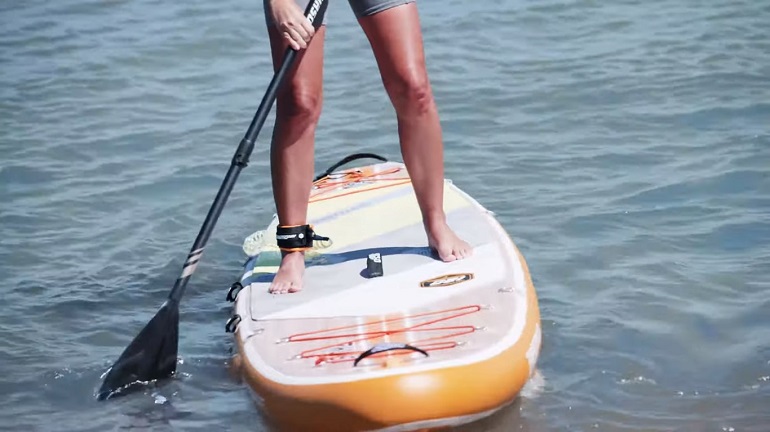
Choosing the best paddle board for beginners can come with its fair share of challenges. One common issue is the overwhelming variety of options available in the market.
With different types of stand-up paddle boards, sizes, shapes, and materials to choose from, beginners may find it difficult to navigate through the choices and determine which one suits their needs and preferences.
Secondly, when researching stand-up paddle board options, it is common to find a limited list of brands that consistently receive positive reviews and recommendations from different sources, such as review sites and influential social media posts.
This convergence of opinions on certain brands can sometimes indicate undue attention given to certain sponsor brands to gain monetary benefits.
The Advertising Problem
In the competitive world of paddle boarding, it’s often the brand with the biggest advertising budget that gets the most attention rather than the best quality paddle boards.
Big retailers and stores follow a similar pattern, prioritizing mass advertising and pushing products for profit, leaving smaller niche businesses behind. Don’t be swayed by the noise, and focus on finding your first paddle board that truly suits your needs rather than the one that’s simply being heavily marketed.
How Does This Affect Purchasing a Paddle Board?
As beginners, we often trust that the information we come across is genuinely in our best interest. However, it’s important to recognize that many prominent paddle board brands, review sites, associations, and authorities are connected to large corporations driven by financial gain.
Their primary focus is maximizing return on investment, which can lead to biased information and an attempt to convince readers that subpar products are superior.
Alternate Options in the Industry
By relying solely on referral sites and online advertisements, you might overlook the smaller brands that prioritize quality and enthusiast-driven values. These brands, which often choose not to participate in incentivized reviews or heavy advertising, are producing some of the best paddle boards available today.
It’s as if there are two distinct universes in the SUP equipment industry: one dominated by mass-market brands chasing quick profits through aggressive marketing and the other consisting of passionate enthusiasts, like us, dedicated to campaigning for genuine, high-performance water sports gear.
How to Choose a Stand-Up Paddle Board: What to Know About Hulls
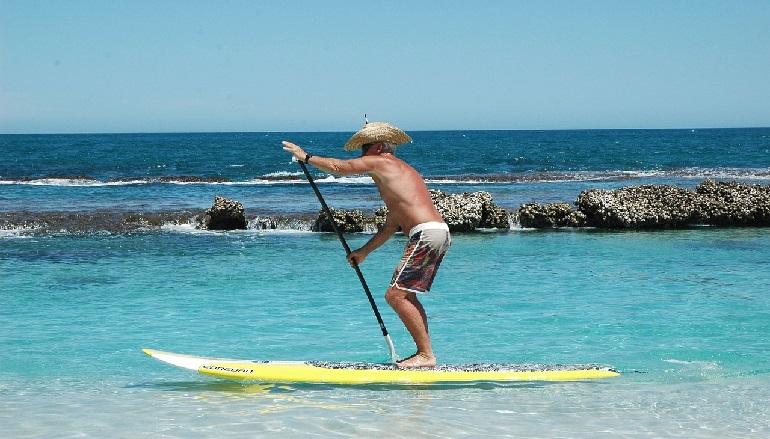
The hull of a paddle board, otherwise known as the body, is the most important factor that affects your board’s performance.
There are two main hull types to choose from, and the great thing is that, for once, your skill level won’t act as a gatekeeper when choosing a sup board. At least, not on the level of, say, bindings in snowboarding.
If you are wondering how the two hull types differ, look down below for a brief overview of both types of paddle boards.
STAND-UP Paddle Board Hull Types
Before we begin with the pros and cons of the two stand-up paddle board types, allow me to tell you that there are a number of hybrid boards. These paddle boards attempt to provide users with the right blend of both main sup boards.
There are many different ways to use a paddle board, and how you decide to use your paddle board will be the main factor in choosing a hull type.
You could race paddle boards (an incredibly fun activity), engage in sup yoga, or you could paddle board for leisure (my personal favorite).
You can buy Fishing Paddle boards if you love to do fishing activities.
Planing Hull (For Leisure and White Waters)
Planing hulls are easy to maneuver; this is why most touring boards are planning hull sups. They are wider with a flat surface.
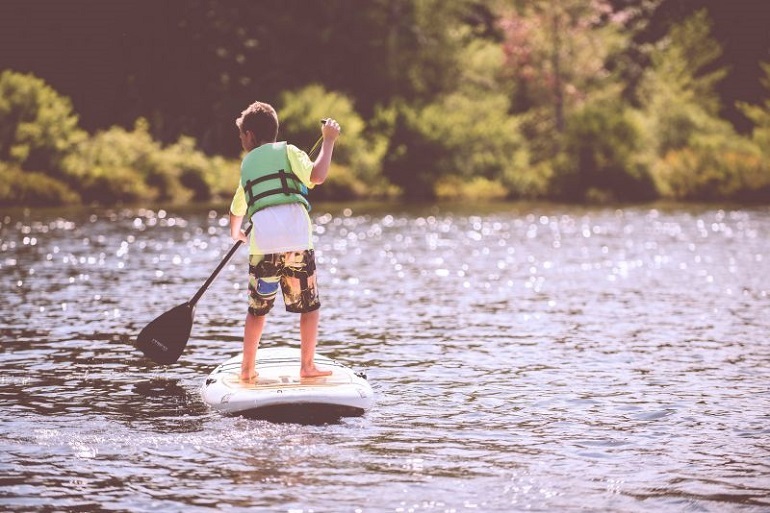
Planing hulls enhance the board’s ability to engage in flat water paddling. If you are looking for a calm and smooth ride, then a planning hull is right for you.
Their overall design resembles a snowboard, but without the upturned edges, this makes for a much wider board than the following displacement hulls.
Displacement Hull (For Cutting Through the Water)
A displacement hull is used for parting through the waters. These paddle boards split through active waters thanks to their pointed nose. Displacement hulls resemble a kayak due to this feature.
Unlike planing hull stand-up paddle boards, this type of hull is designed for efficiency and speed. A proper race board performs in any condition thanks to this type of hull.
Narrower boards surprisingly require less effort to travel at faster speeds and for longer distances than their hull counterparts.
A displacement hull stand-up paddle board is best used for an exercise session, touring, and racing.
Your Activity Will Determine Your Board Size.
The hull type of inflatable board won’t be the only determining factor in how you use your board. The size of your inflatable sup board matters as well. This is because the length of your board determines how it handles.
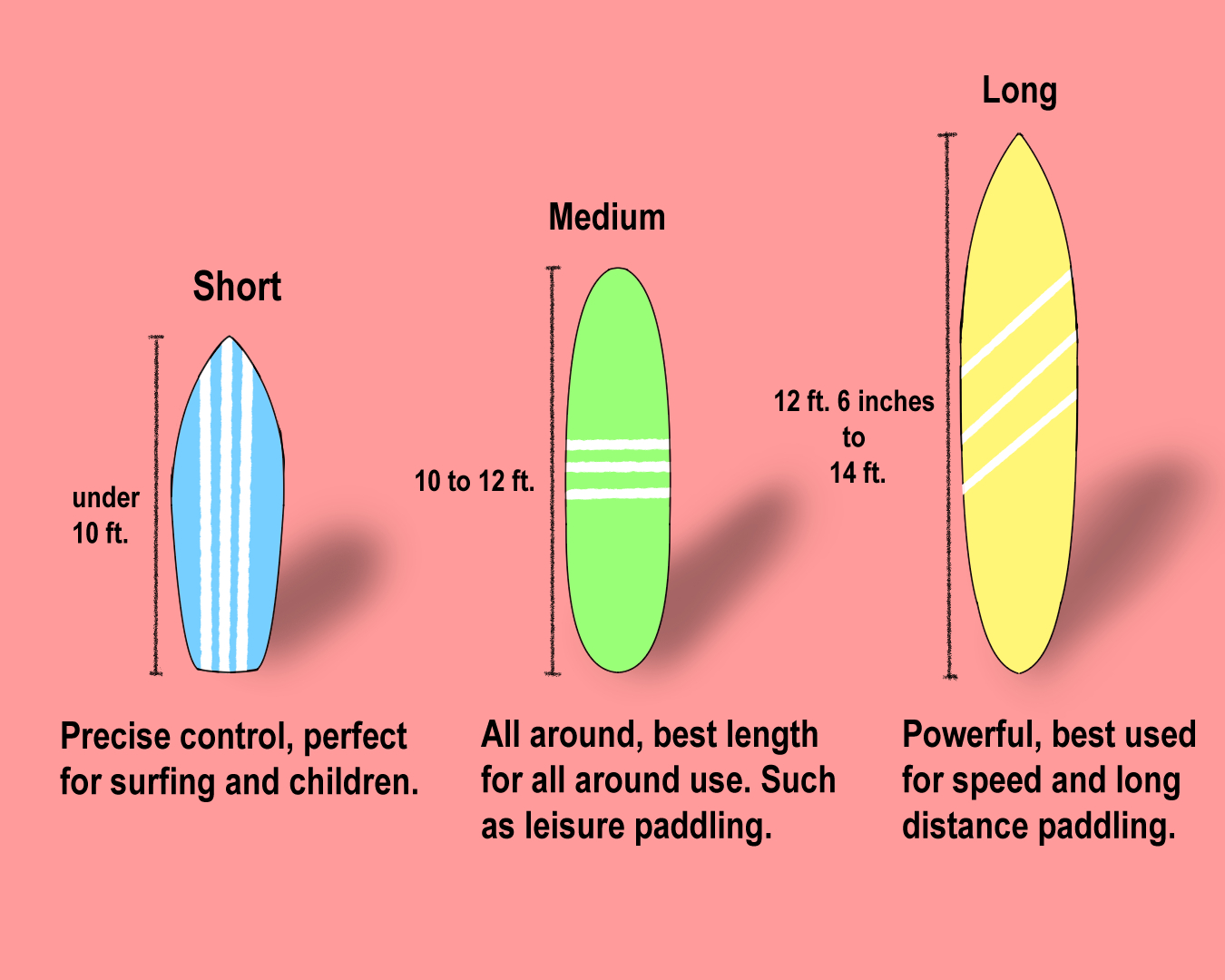
A board can be broken up into three size categories: small, medium, and large.
Small – Sometimes Smaller is Better
Most paddle boards under 10 feet in length are short boards. Smaller boards make some of the best surfing paddleboards and boards for children, largely for the same reason but in different situations.
These boards are adequate for surfing because they are much easier to control than a longer board. It takes less effort and time to change course on a small-size board, and this is why you can catch waves, often a fast-paced and dynamic activity, with these boards.
This means that a small board is very likely to have a planing hull.
The reason why children should use these boards is that kids are smaller than adults, and as a result, they would not be able to control anything larger than this. You may create precious experiences on the lake with your family if you choose the correct kid’s sup paddle board.
Medium – The All-Around Choice
If you want to engage in some sup yoga, then a good size paddle board would be anything between 10 and 12 feet. Anything within this range is medium-sized and ideal for any paddling style or activity.
Frequently equipped with a planing hull, but it is not unheard of for boards of this size to come with a displacement body form.
Long – All About Speed and Distance
Anything 12 and a half feet or higher is considered a longboard. Longer boards are best used if you want to travel far at a rapid pace. The common hull type here is a displacement body due to the sharp and pointed nose, which cuts through the water with greater ease.
This pointed bow fights against any resistance that the waters may hurl against you. This is why less energy is required of you in order to travel. Although, tight turns with this length are much more difficult. Best used for chartering a straight course.

Are You a Beginner, Intermediate, or Experienced Paddler?
I mentioned earlier that your skill level wouldn’t be as important for choosing the right equipment when paddling as compared to other sports. What activity you plan on doing will ultimately decide what paddle board you choose.
But if you truly want to consider your skill level and have it play a role in your decision-making process, then there are a few things to look out for.
Choose the board that has a 2-person paddle board capacity if you are interested to paddle with your partner. If you’re an experienced paddler looking to challenge and refine your skills, reading a Blue Fin Sprint review can provide valuable insights into the features and performance of expert paddle boards.
Thickness
Namely, any beginner paddlers looking to receive as much as they can from their equipment should be on the lookout for a board that is 4 to 6 inches in thickness. The thicker the board, the more raised from the water you will be.
Length
When it comes to length, a medium-sized board should do the trick. An all-around option will allow you to experiment with what kind of activities you want to be engaging in. Once you find something you want to specialize in, then you can seek out equipment that is better suited for that specific task.
Width
Finally, the wider your board, the more stable it will be. I know from experience that when engaging in any kind of water sport, balance is the first thing you should focus on and also the hardest skill for most beginners to get down right.
This is why you should build your confidence with a wider board, and as we know, wider boards are those with a planning hull rather than a displacement hull.
Solid vs. Inflatable SUPs
Decisions, decisions. That is what sports are all about, and paddle boarding is no exception. The next choice for you to consider on your quest to begin engaging in this thrilling and oftentimes daring sport is whether you want an inflatable paddle board or solid sup.
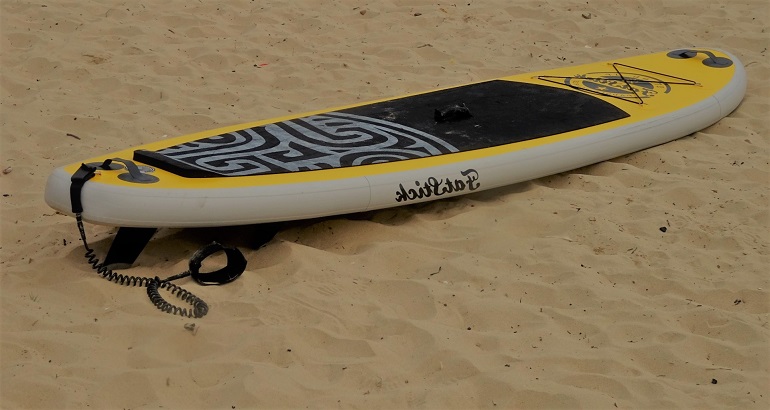
Pros and Cons of a Solid SUP
Hard boards are better for precise maneuvering because they are far more responsive to the waters below. This is why they are an excellent choice for competitions and performing tricks.
A solid sup is convenient because it’s always ready to be used. No waiting around, all you need to do is haul it to a body of water and get going. Inflatable sups can take up to 15 minutes to inflate before they are ready to go.
Finally, solid sups are much more durable with eps foam core, and they last longer than one that is inflatable. No need to worry about any punctures or whether your board is pressurized correctly.
Pros
- Always ready for use.
- Durable and reliable.
- More control and responsiveness.
Cons
- Harder to store.
- Difficult to haul around due to weight and size.
- More expensive than inflatable paddle boards.
Pros and Cons of an Inflatable SUP
Inflatable sup is much easier to store and transport because it can be pressed down into a compacted form.
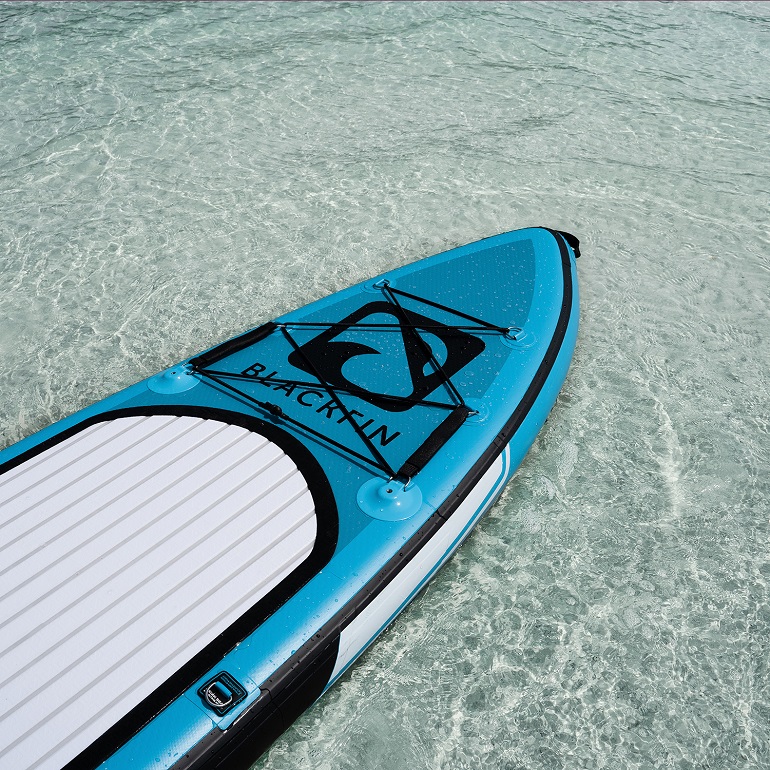
Take the air out, and all you are left with is essentially a deflated balloon that can be rolled up and strapped to your back.
These types of inflatable boards aren’t as hard on your feet because they aren’t solid all the way through. Injuries and a few painful bumps are less likely to happen with an inflatable paddle board, and this is the number one reason why I would recommend this board type. You can extend the life of your board and conserve space by knowing how to store your paddle board.
The last thing to consider is that these are by far the cheaper paddleboard option.
Pros
- Lower price point.
- Easier to store and haul.
- Softer landings.
Cons
- Not as durable or long-lasting.
- Must be inflated before use.
The Build of a SUP and Its Importance
There are several smaller details that comprise either a quality solid or quality inflatable board. The following sections will explain in depth what each of these features is and why they are important for any good paddle board.
- SUP Volume and Weight Capacity: Choose a board that has the weight capacity to withstand your body. If your board’s weight capacity isn’t enough to sustain you, then the overall stability of the board will go down.
A paddle board’s volume determines how great its weight capacity will be. A higher volume indicates the ability to handle a higher amount of weight. As a result, volume and weight capacity are intrinsically linked. - SUP Length: I don’t want to repeat myself when it comes to length, as I have already talked about this in-depth earlier. A quick summary would be that the smaller the board, the greater your control. Larger boards are built for speed and distance.
This is true whether using solid or inflatable paddle boards. Keep in mind that the length of a board also affects the board’s volume and weight capacity. - SUP Width: The wider a board is, the more stability it will have, but your size must also be considered. Smaller individuals should seek out a narrower board, and bigger people should get a wider board.
For those looking to go faster or for a more intense paddling activity, then choose a narrower board, one with a displacement-styled body shape. - SUP Thickness: Two identical boards with different levels of thickness can vary wildly in how they are used and their overall performance. Ultimately, every factor mentioned on this list will be tied to a paddle board’s weight capacity and volume.
A board’s thickness is the final factor to take into consideration when seeking out a properly weighted board. - SUP Fins: Fins are added to a paddle board in order to boost tracking and stability. A large center fin will result in a more stable ride and one that is easier to maintain on a straight course. Smaller fins are used for increased control and maneuverability.
Most fins are detachable semi-rigid fins. Inflatable paddle boards come with flexible rubber fins attached, and just like the semi-rigid fins, they can be swapped out. For flatwater paddling, use a single fin as it provides you with minimal drag. Surfers should use either a 3-fin structure or a 2+1 fin layout for enhanced control.
Thinking About Where Will You Store Your Paddle Board
Solid sups are huge, and they will not be easy to store. Sadly, unless you have a house with either a large garage or backyard, then you should stay away from these types of sups.
For those paddle boarders that live in an apartment or are afraid to have their board stolen if left outside, then realistically, your only real option is to purchase an inflatable sup board.
Even if you do have the space required, something else to consider is whether you have a roof rack on your vehicle or the strength required to transport a solid board.
Closing Thoughts
The paddle board plays into who you are. Choose a paddle board that feels like an extension of your own body. You will see benefits in responsiveness and your overall experience. First, consider what it is you want to do, and then begin to take into account your weight and overall size.
Now you know how to choose a paddle board; you can also look into the differences between oar vs. paddle to make the right choice in that regard too.
If you’ve ever wondered why are paddle boards so expensive, it’s because a lot goes into their manufacturing. However, paddle boarding is an easy sport to get into; all you need is a firm idea of what kind of activity you will be engaging in. You can also take a look at the dog-friendly paddle board options if you wish to take your pup along on the journey.
Pick up your paddleboard, strap your best paddleboarding shoes on, and get ready to embark on an amazing adventure. If you’re not up for standing long hours and just want to have a calm day out on the waters, you can take a look at the floating mats available on the market.
Happy paddle boarding!
0 Comments